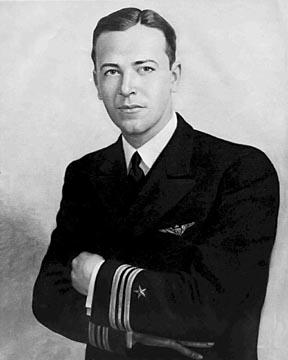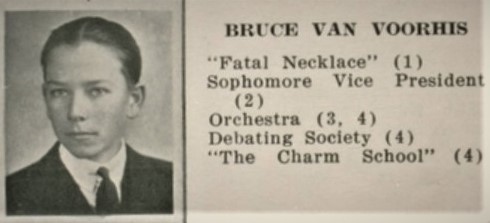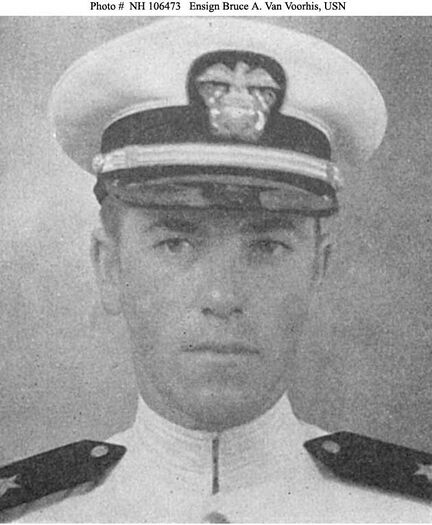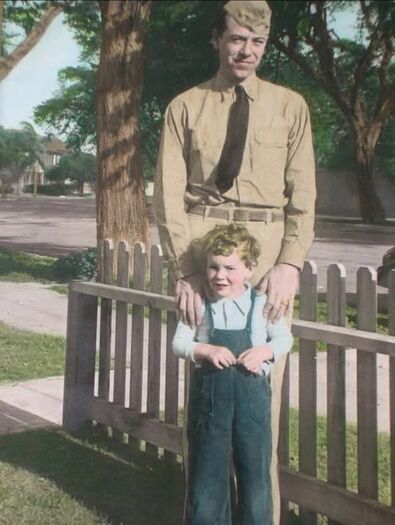BRUCE A. VAN VOORHIS, CDR, USN
Bruce Van Voorhis '29
Lucky Bag
From the 1929 Lucky Bag:
BRUCE AVERY VAN VOORHIS
Fallon, Nevada
"Van" "Chicken" "Brute"
THEY discovered Van out in the wilds of Nevada, saw that the Navy could not do without him, and made him a midshipman. Plebe summer he spent most of his time teaching the city slickers from the East the correct pronunciation of "Nevada." Boning, for him, seems to be an unnecessary evil. About once a year he gets ambitious, does a little serious boning, and pulls star grades for the month. He then secures for the year, thinking he has done his duty by Uncle Sam and earned his $780. Every spring he gets restless, makes out his resignation, and plans big things; but he never gets around to turning it in. We shall find him in the Navy until he gets too old and decrepit to be of any further use.
Chicken does not fall in love, but in three cruises and four years in blue serge and brass buttons has left a trail of broken hearts extending the full lengths of both coasts and radiating for miles around Crabtown.
Van knows what he wants and usually gets it. This should bring him success in the Navy or in any other line he might enter. Aside from being a fresh air fiend and having a depraved taste in Vic records, he has been a good wife—which is, after all, the true test of a good man.
Class Baseball 2. Gymkhana 4. Orchestra 4. Wrestling 4. 1 P.O.
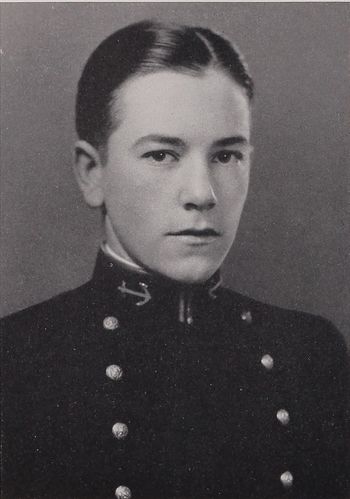
BRUCE AVERY VAN VOORHIS
Fallon, Nevada
"Van" "Chicken" "Brute"
THEY discovered Van out in the wilds of Nevada, saw that the Navy could not do without him, and made him a midshipman. Plebe summer he spent most of his time teaching the city slickers from the East the correct pronunciation of "Nevada." Boning, for him, seems to be an unnecessary evil. About once a year he gets ambitious, does a little serious boning, and pulls star grades for the month. He then secures for the year, thinking he has done his duty by Uncle Sam and earned his $780. Every spring he gets restless, makes out his resignation, and plans big things; but he never gets around to turning it in. We shall find him in the Navy until he gets too old and decrepit to be of any further use.
Chicken does not fall in love, but in three cruises and four years in blue serge and brass buttons has left a trail of broken hearts extending the full lengths of both coasts and radiating for miles around Crabtown.
Van knows what he wants and usually gets it. This should bring him success in the Navy or in any other line he might enter. Aside from being a fresh air fiend and having a depraved taste in Vic records, he has been a good wife—which is, after all, the true test of a good man.
Class Baseball 2. Gymkhana 4. Orchestra 4. Wrestling 4. 1 P.O.
Loss
Bruce was killed in action on July 6, 1943 when the PB4Y-I patrol bomber he was piloting was shot down over a Japanese installation at Kapingamarangi Atoll. He was the commanding officer of Bombing Squadron (VB) 102; he was posthumously awarded the Medal of Honor and promoted to Commander.
Photographs
Other Information
From Arlington National Cemetery:
Bruce Avery Van Voorhis (29 January 1908 - 6 July 1943) was a United States Navy aviator who was shot down in the Pacific theater during World War II. For his heroic action on July 6, 1943, he was posthumously awarded the Medal of Honor. Van Voorhis was born on 29 January 1908 in Aberdeen, Washington, and grew up in Nevada, He was appointed to the Naval Academy in June 1925.
Following graduation from the Academy on 6 June 1929, Ensign Van Voorhis reported for duty in the battleship Mississippi (BB-41). That assignment lasted until November 1930 when he transferred to the Naval Air Station at Pensacola, Florida, for aviation training.
He received his wings on 3 September 1931, and was assigned to the Maryland (BB-46) as a member of Observation Squadron 4B (VO-4B). In June 1934, he transferred to Bombing Squadron 5B on board the aircraft carrier Ranger (CV-4), and soon thereafter, to VB-2B attached to Saratoga (CV-3). From July 1935 until May 1937, he served in the Panama Canal Zone and flew patrols from Coco Solo with Patrol Squadron 2F (VP-2F). The following June, 1938, Van Voorhis returned to carried-based aviation and served first in Enterprise (CV-6), then in Yorktown (CV-5), and finally back to Enterprise. In June 1940, Van Voorhis joined the aviation unit assigned to the light cruiser Honolulu (CL-48) where he served for a year. In July 1941, he reported for duty at the Naval Air Station, Anacostia, where he served until November 1942.
In December 1942, Van Voorhis, a Lieutenant Commander since July, assumed command of VP-14, but soon thereafter took command of VB-102. While serving in that capacity, LCDR Van Voorhis gave his life for his country near Hare Island of Kapingamarangi Atoll, the southernmost of the Eastern Caroline Islands. After a 700-mile flight alone, LCDR Van Voorhis launched successive bombing and strafing attacks on the enemy ground installations. During his onslaught, he succeeded in destroying a radio station, anti-aircraft emplacements, and at least one airborne fighter as well as three others on the water. However, the strength of Japanese aerial opposition eventually forced Van Voorhis lower and lower until either the intense anti-aircraft barrage, the fighters, or-perhaps-his own bomb blasts knocked him out of the sky near the island. For the ". . . conspicuous gallantry and intrepidity . . ." he displayed in his ". . . lone but relentless battle against overwhelming opposition . . ." He died on July 6, 1943 and was awarded the Medal of Honor, posthumously.
From the Reno Gazette-Journal, October 9, 1944, via researcher Kathy Franz:
How the navy’s search planes keep tab on where the Japanese are and what they are doing and the part Lt. Com. Bruce A. Van Voorhis of Fallon took, is told in an article in the Liberty magazine, under the title “Thousand-Mile Eyes.” . . . [The article by Sidney Shalett was in v. 21, #39, dated September 23, 1944. On the cover was the Distinguished Service Cross.]
The article reads in part: “Before the squadron had left the area in September 1943, after having flown 8000 hours against the Japs, its successor squadron, originally under the command of Lt. Com. Bruce A. Van Voorhis, had come in. As a result of the other squadron’s experience, the new Liberators came in with nose turrets, which helped them give a better account of themselves in head-on fights with Jap fighters. Things still were pretty primitive on Guadalcanal, though. For awhile the mammoth planes had to be gassed up by hand with seven and one-half gallon cans, that meant 360 pouring operations. “One day Com. Van Voorhis flew over to Kapingamarangi (Greenwich Island) alone, trying to get a seaplane tender anchored there. He never came back. Other planes were lost later on the same mission.”
From researcher Kathy Franz:
Bruce graduated in 1924 from the Churchill County High School, aka Fallon High School. He played clarinet in the orchestra. Class Will: bequeathed his executive ability. Class Prophecy: Captain Van Voorhis’ ship is the U. S. S. Nevada. From the Senior Raspberry section: As We Know Them: Clint. Favorite Saying: “Aw go on.” Favorite Song: “Kiss Me Again.” Ambition: Agriculturist. Future: Pugilist.
In 1927, his brother Wayne was named by Congressman Arentz to West Point. He later graduated from the University of Nevada in 1934.
On February 19, 1938, in Beaufort, South Carolina, Bruce married Mrs. Kathryn Warden, daughter of Navy Commander and Mrs. H. D. Johnson. Their first son was Bruce who was born in the fall of 1939 in California, and their second son John Avery was born on July 6, 1941, in Alexandria, Virginia.
On November 6, 1941, Bruce was promoted to lieutenant-commander. He had previously taken a course in chemical warfare. In December 8, 1941, the Reno Gazette-Journal reported that he was in Honolulu.
In the fall of 1942, Bruce was transferred to the Pacific Coast and was on active duty in the South Pacific. His wife and sons, Richard (by her first marriage), Bruce and John, lived in San Diego.
In January, 1929, his mother, now Mrs. Leo Pinger, was elected to the Nevada legislature. His step-father was manager of the lumber department of the I. H. Kent Company at Fallon. He died in December, 1941. His brother Wayne was missing after the fall of Corregidor and died from malaria in the Japanese prisoner of war Camp O’Donnel on July 10, 1942.
Across the Road: Fallon Indian Day School [1908-1943] and the Baptist Indian Mission by Pam Nelson
W. A. Van Voorhis of Tahalah, Washington, came to Nevada in January of 1909 to administrate the Fallon Indian Day School. He was accompanied by his wife, Lillie, baby, Bruce and his wife' s mother, and the family made their home in Stillwater. Van Voorhis had worked for the Indian Service on the Quinoriet Indian Reservation in Washington so he was experienced at this type of work. One of the first projects facing Van Voorhis was the installation of a cement cistern of 110 barrel capacity, to supply water for domestic purposes. It was made of brick faced with cement and designed to be tightly covered. Filtered ditch water was used as the water source. The cistern was successfully installed by Walter Busch of the firm Busch & Henriksen. . . . The tank had a capacity of 2,000 gallons, and the water was to be pumped with a gasoline engine.
Although cold weather did not force the school to close, in February 1910 Indian Agent Van Voorhis temporarily stopped classes to halt the spread of small pox or chicken pox, one of which was active in the area at the time. This precautionary measure was upheld until all signs of the disease had cleared the area. A new disease entered the reservation in the early spring of March 1910 and spread among the Indian people at an alarming rate. The first symptom of this disease, Trachoma, was pain in the eyeballs as they became bloodshot. The eye's pupils would be affected next and they would contract, until, eventually, sight was lost. Trachoma was confined to the Indian people of Stillwater and was not transmitted to the white population. Day School children were not involved in the screening process for trachoma, but, to help avoid an epidemic, missionary women kept busy screening the adult Indian population at Stillwater for this highly communicable disease. Authorities warned of employing adult Indians outside of the reservation unless they were examined by a physician and found to be free from the malady.
A new school year for the Stillwater Indian children began on September 18, 1911, with the addition of a new teacher. Mrs. Peter Cook temporarily filled the teaching position until the regular teacher arrived. That same year Van Voorhis was impressed with the crops on the reservation and commented they were better than the previous year with 60% more yield.
In addition to starting a new school year and harvesting more bountiful crops, Van Voorhis worked on a plan to employ two Indian policemen with the condition that the county pay the salary for one and the government pay for the other. The Indian police, it was felt, would get better results among their tribesmen than could be achieved by white officers. It was claimed that Van Voorhis was a very efficient superintendent of the Fallon Indian School. Added to his position was the overseeing of the Lovelock Indian School after their superintendent was transferred to Cass Lake, Idaho, to take charge of the Indian boarding school there. . . .
The Van Voorhis family transferred to Fort Washake, Wyoming and Van Voorhis took over the Indian agency there. After nine months of working at Fort Washake, VanVoorhis resigned his position as Indian agent in order to return to Fallon to live where his children would receive the benefit of good schools. He accepted a position with the I.H. Kent Company. Almost nine months later, on January 8, 1919, W. A. Van Voorhis died at his home from pneumonia. Van Voorhis had spent eight years as the Indian agent at the Indian Reservation near Stillwater. The Fallon Indian Day School had been under his guidance during the early years of its existence. Van Voorhis was a genial man, respected and liked by all. He was survived by his wife Lillie, and sons Bruce and Wayne. (The two Van Voorhis sons were destined to die heroes in WWII. Van Voorhis Field, at NAS Fallon, is named for Bruce.)
His wife was listed as next of kin; she was a widower with a son, and she and Bruce had another two sons together.
Bruce has a memory marker in Arlington National Cemetery; he is buried in Missouri.
Medal of Honor
From Hall of Valor:
The President of the United States of America, in the name of Congress, takes pride in presenting the Medal of Honor (Posthumously) to Lieutenant Commander Bruce Avery Van Voorhis, United States Navy, for conspicuous gallantry and intrepidity at the risk of his life above and beyond the call of duty as Squadron Commander of Bombing Squadron ONE HUNDRED TWO (VB-102) and as Plane Commander of a PB4Y-I Patrol Bomber operating against the enemy on Japanese-held Greenwich Island during the battle of the Solomon Islands, 6 July 1943. Fully aware of the limited chance of surviving an urgent mission, voluntarily undertaken to prevent a surprise Japanese attack against our forces, Lieutenant Commander Van Voorhis took off in total darkness on a perilous 700-mile flight without escort or support. Successful in reaching his objective despite treacherous and varying winds, low visibility and difficult terrain, he fought a lone but relentless battle under fierce anti-aircraft fire and overwhelming aerial opposition. Forced lower and lower by pursuing planes, he coolly persisted in his mission of destruction. Abandoning all chance of a safe return he executed six bold ground-level attacks to demolish the enemy's vital radio station, installations, anti-aircraft guns and crews with bombs and machinegun fire, and to destroy one fighter plane in the air and three on the water. Caught in his own bomb blast, Lieutenant Commander Van Voorhis crashed into the lagoon off the beach, sacrificing himself in a single-handed fight against almost insuperable odds, to make a distinctive contribution to our continued offensive in driving the Japanese from the Solomons and, by his superb daring, courage and resoluteness of purpose, enhanced the finest traditions of the U.S. Naval Service. He gallantly gave his life for his country.
Service: Navy
Rank: Lieutenant Commander
Namesakes
USS Van Voorhis (DE 1028) was named for Bruce; the ship was sponsored by his widow.
The airfield at Naval Air Station Fallon is also named in his honor. There is also a United States Naval Sea Cadet Corps unit (the Van Voorhis squadron) in Las Vegas, Nevada.
The "Register of Commissioned and Warrant Officers of the United States Navy and Marine Corps" was published annually from 1815 through at least the 1970s; it provided rank, command or station, and occasionally billet until the beginning of World War II when command/station was no longer included. Scanned copies were reviewed and data entered from the mid-1840s through 1922, when more-frequent Navy Directories were available.
The Navy Directory was a publication that provided information on the command, billet, and rank of every active and retired naval officer. Single editions have been found online from January 1915 and March 1918, and then from three to six editions per year from 1923 through 1940; the final edition is from April 1941.
The entries in both series of documents are sometimes cryptic and confusing. They are often inconsistent, even within an edition, with the name of commands; this is especially true for aviation squadrons in the 1920s and early 1930s.
Alumni listed at the same command may or may not have had significant interactions; they could have shared a stateroom or workspace, stood many hours of watch together, or, especially at the larger commands, they might not have known each other at all. The information provides the opportunity to draw connections that are otherwise invisible, though, and gives a fuller view of the professional experiences of these alumni in Memorial Hall.
July 1929
October 1929
January 1930
October 1930
LT Paul Thompson '19
LT Irving Wiltsie '21
LTjg Matthias Marple, Jr. '23
LTjg Robert Larson '24
LTjg James McDonough '24
LTjg John Waldron '24
LTjg Charles McDonald '24
LTjg Richard Moss '24
January 1931
LT Paul Thompson '19
LT Irving Wiltsie '21
LTjg Matthias Marple, Jr. '23
LTjg Robert Larson '24
LTjg James McDonough '24
LTjg John Waldron '24
LTjg Charles McDonald '24
LTjg Richard Moss '24
LTjg John Duke '26
April 1931
LT Irving Wiltsie '21
LTjg Matthias Marple, Jr. '23
LTjg Robert Larson '24
LTjg James McDonough '24
LTjg John Waldron '24
LTjg Charles McDonald '24
LTjg Richard Moss '24
LTjg John Duke '26
LTjg James Averill '27
LTjg William Potts '27
July 1931
LT Irving Wiltsie '21
LTjg Matthias Marple, Jr. '23
LTjg Robert Larson '24
LTjg James McDonough '24
LTjg Charles McDonald '24
LTjg Richard Moss '24
LTjg Carlton Hutchins '26
LTjg Charles Signer '26
LTjg John Duke '26
LTjg William Potts '27
October 1931
ENS John Shaffer, III '30 (USS Maryland)
ENS Thomas Ashworth, Jr. '31 (USS Maryland)
January 1932
April 1932
October 1932
ENS Edward Blessman '31 (USS Maryland)
ENS Elliott Marshall '31 (USS Maryland)
ENS Arthur Vorpahl '32 (USS Maryland)
ENS Robert Strickler '32 (USS Maryland)
January 1933
ENS Thomas Ashworth, Jr. '31 (USS Maryland)
ENS Edward Blessman '31 (USS Maryland)
ENS Elliott Marshall '31 (USS Maryland)
ENS Arthur Vorpahl '32 (USS Maryland)
ENS Robert Strickler '32 (USS Maryland)
April 1933
ENS Thomas Ashworth, Jr. '31 (USS Maryland)
ENS Edward Blessman '31 (USS Maryland)
ENS Elliott Marshall '31 (USS Maryland)
ENS Arthur Vorpahl '32 (USS Maryland)
ENS Robert Strickler '32 (USS Maryland)
July 1933
ENS Truman Carpenter '32 (USS Maryland)
ENS Arthur Vorpahl '32 (USS Maryland)
ENS Joseph Bourland '33 (USS Maryland)
ENS John Phillips, Jr. '33 (USS Maryland)
October 1933
ENS Truman Carpenter '32 (USS Maryland)
ENS Arthur Vorpahl '32 (USS Maryland)
April 1934
July 1934
LT LaRue Lawbaugh '20 (Fighting Plane Squadron (VF) 3B)
LT Robert Bedilion '22 (USS Ranger)
LTjg William Pennewill '29 (Bombing Plane Squadron (VB) 3B)
ENS William Sisko '31 (USS Ranger)
2LT Robert Brown '31 (USS Ranger)
ENS Earle Schneider '33 (USS Ranger)
October 1934
LT Arnold Isbell '21 (Aircraft Squadrons)
LT John Jones '21 (USS Saratoga)
LT Matthias Marple, Jr. '23 (Fighting Plane Squadron (VF) 6B)
LTjg Harold Richards '27 (Aircraft Squadrons)
LTjg Loren Morris '27 (Scouting Plane Squadron (VS) 2B)
LTjg Leonard Southerland '27 (Fighting Plane Squadron (VF) 6B)
LTjg Carl Lindgren '28 (Scouting Plane Squadron (VS) 2B)
LTjg Mathias Wyatt '29 (Fighting Plane Squadron (VF) 6B)
LTjg Charles Ostrom '30 (Scouting Plane Squadron (VS) 2B)
LTjg James Murphy '31 (Torpedo Plane Squadron (VT) 2B)
ENS George Stone '31 (USS Saratoga)
ENS Albert Gates, Jr. '32 (USS Saratoga)
ENS Bertram Prueher '33 (USS Saratoga)
ENS Paul Burton '33 (USS Saratoga)
ENS Robert Fair '33 (USS Saratoga)
ENS Wendell Froling '34 (USS Saratoga)
January 1935
LT Arnold Isbell '21 (Aircraft Squadrons)
LT John Jones '21 (USS Saratoga)
LT Matthias Marple, Jr. '23 (Fighting Plane Squadron (VF) 6B)
LTjg Harold Richards '27 (Aircraft Squadrons)
LTjg Loren Morris '27 (Scouting Plane Squadron (VS) 2B)
LTjg Leonard Southerland '27 (Fighting Plane Squadron (VF) 6B)
LTjg Carl Lindgren '28 (Scouting Plane Squadron (VS) 2B)
LTjg Mathias Wyatt '29 (Fighting Plane Squadron (VF) 6B)
LTjg Charles Ostrom '30 (Scouting Plane Squadron (VS) 2B)
LTjg James Murphy '31 (Torpedo Plane Squadron (VT) 2B)
LTjg Edward Blessman '31 (Aircraft Squadrons)
LTjg George Stone '31 (USS Saratoga)
ENS Albert Gates, Jr. '32 (USS Saratoga)
ENS Bertram Prueher '33 (USS Saratoga)
ENS Paul Burton '33 (USS Saratoga)
ENS Robert Fair '33 (USS Saratoga)
ENS Wendell Froling '34 (USS Saratoga)
April 1935
LT Arnold Isbell '21 (Aircraft Squadrons)
LT John Jones '21 (USS Saratoga)
LT Matthias Marple, Jr. '23 (Fighting Plane Squadron (VF) 6B)
LTjg Harold Richards '27 (Aircraft Squadrons)
LTjg Loren Morris '27 (Scouting Plane Squadron (VS) 2B)
LTjg Leonard Southerland '27 (Fighting Plane Squadron (VF) 6B)
LTjg Mathias Wyatt '29 (Fighting Plane Squadron (VF) 6B)
LTjg Ford Wallace '31 (Fighting Plane Squadron (VF) 6B)
LTjg James Murphy '31 (Torpedo Plane Squadron (VT) 2B)
LTjg Edward Blessman '31 (Scouting Plane Squadron (VS) 2B)
ENS Albert Gates, Jr. '32 (USS Saratoga)
ENS Bertram Prueher '33 (USS Saratoga)
ENS Paul Burton '33 (USS Saratoga)
ENS Wendell Froling '34 (USS Saratoga)
October 1935
January 1936
April 1936
July 1936
January 1937
April 1937
September 1937
January 1938
July 1938
LCDR William Ault '22 (Torpedo Squadron (VT) 6)
LT Gilbert Carpenter '30 (USS Enterprise)
LTjg Alfred Tucker, III '31 (Torpedo Squadron (VT) 6)
LTjg John Phillips, Jr. '33 (Torpedo Squadron (VT) 6)
LTjg Walker Ethridge '34 (Bombing Squadron (VB) 6)
LTjg Philip Torrey, Jr. '34 (Bombing Squadron (VB) 6)
ENS Webster Johnson '36 (USS Enterprise)
ENS Bruce Skidmore '37 (USS Enterprise)
ENS Ernest Wood, Jr. '38 (USS Enterprise)
January 1939
LCDR William Ault '22 (Torpedo Squadron (VT) 6)
LT Gilbert Carpenter '30 (USS Enterprise)
LTjg Alfred Tucker, III '31 (Torpedo Squadron (VT) 6)
LTjg John Phillips, Jr. '33 (Torpedo Squadron (VT) 6)
LTjg Walker Ethridge '34 (Bombing Squadron (VB) 6)
LTjg Philip Torrey, Jr. '34 (Bombing Squadron (VB) 6)
ENS Webster Johnson '36 (USS Enterprise)
ENS Bruce Skidmore '37 (USS Enterprise)
ENS Ernest Wood, Jr. '38 (USS Enterprise)
October 1939
June 1940
November 1940
April 1941
Memorial Hall Error
Bruce is listed in Memorial Hall as a LCDR; he was posthumously promoted to Commander.

The "category" links below lead to lists of related Honorees; use them to explore further the service and sacrifice of alumni in Memorial Hall.
